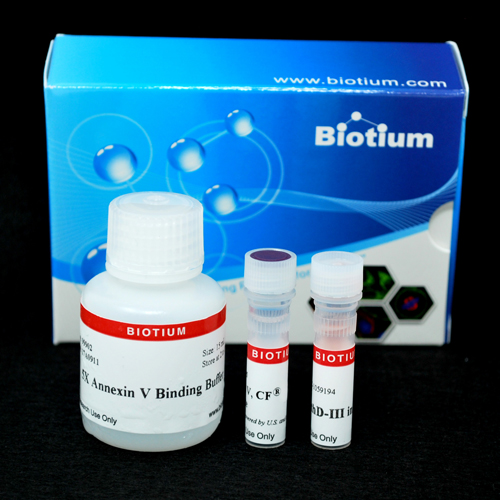Apoptosis and Necrosis Quantitation Kit Plus
A convenient assay for quantifying apoptotic (green) and necrotic (red) cells within the same cell population by flow cytometry or fluorescence microscopy.
Please fill in the inquiry form and we will contact you shortly.
Wishlist updated! View wishlist
Product Description
The Apoptosis and Necrosis Quantitation Kit Plus provides a convenient assay for quantifying apoptotic (green) and necrotic (red) cells within the same cell population by flow cytometry or fluorescence microscopy.
Features
- Simultaneous detection of apoptotic & necrotic cells
- 15-30 minute staining
- Next-generation CF®488A is brighter and more photostable than FITC
- EthD-III is a superior alternative to PI and EthD-I
Kit Components
- CF®488A Annexin V (human; recombinant, produced in E. coli)
- Ethidium Homodimer III (EthD-III)
- 5X Annexin Binding Buffer
Spectral Properties
- CF®488A Annexin V: Ex/Em 490/515 nm
- EthD-III: Ex/Em 279, 532/625 nm (with DNA)
Apoptosis and necrosis are two major processes by which cells die. Apoptosis is an active, genetically regulated disassembly of the cell from within. During apoptosis, phosphatidylserine (PS) is translocated from the inner to the outer leaflet of the plasma membrane for phagocytic cell recognition. The human anticoagulant Annexin V is a 35 kDa, Ca2+-dependent phospholipid-binding protein with high affinity for PS. Annexin V labeled with CF®488A stains apoptotic cells green by binding to PS exposed on the cell surface. CF®488A is spectrally similar to fluorescein (FITC), with much brighter and more photostable fluorescence.
Necrosis normally results from severe cellular insult. Both internal organelle and plasma membrane integrity are lost, resulting in the release of cellular contents into the surrounding environment. Ethidium Homodimer III (EthD-III) is a highly positively charged nucleic acid probe, which is impermeant to live cells, but stains cells with compromised membrane integrity with red fluorescence. EthD-III is a superior alternative to Propidium Iodide (PI) or Ethidium Homodimer I because of its significantly higher affinity for DNA and higher fluorescence quantum yield. The Apoptosis & Necrosis Quantitation Kit Plus provides a convenient assay for quantifying apoptotic (green) and necrotic (red) cells within the same cell population by flow cytometry or fluorescence microscopy.
See our full selection of Cell Viability & Apoptosis Assays and Viability & Apoptosis Assays for Flow Cytometry.


